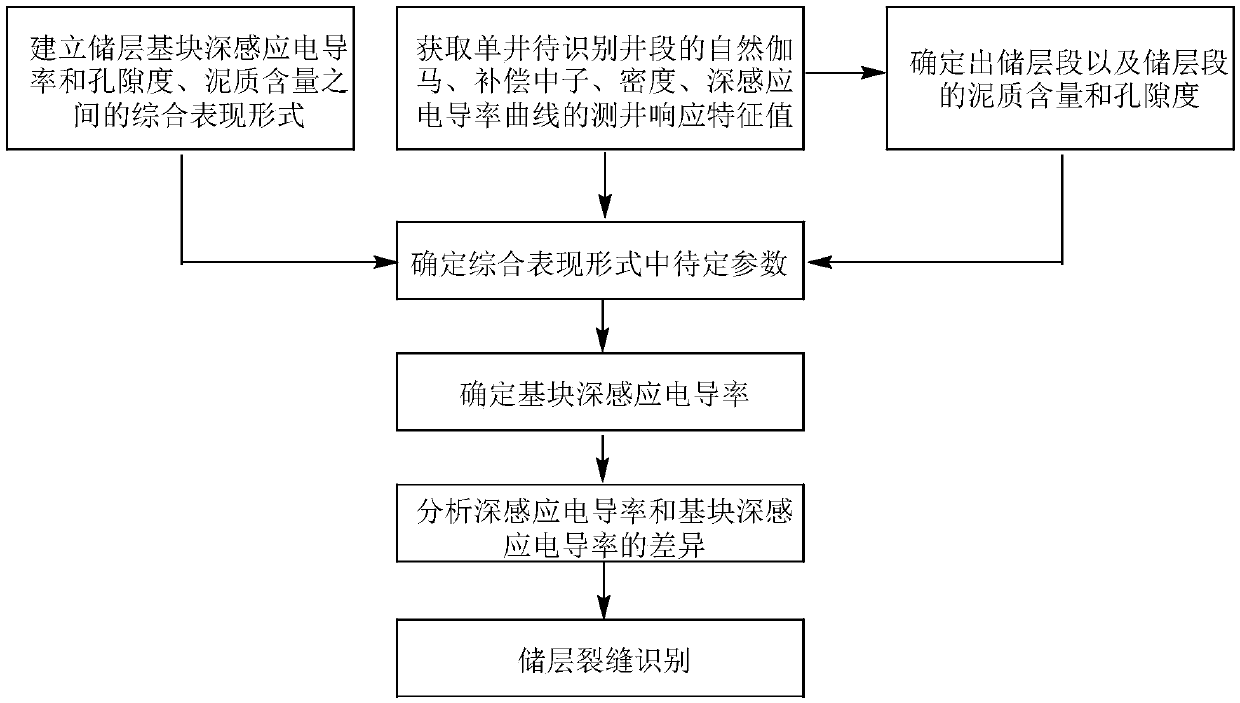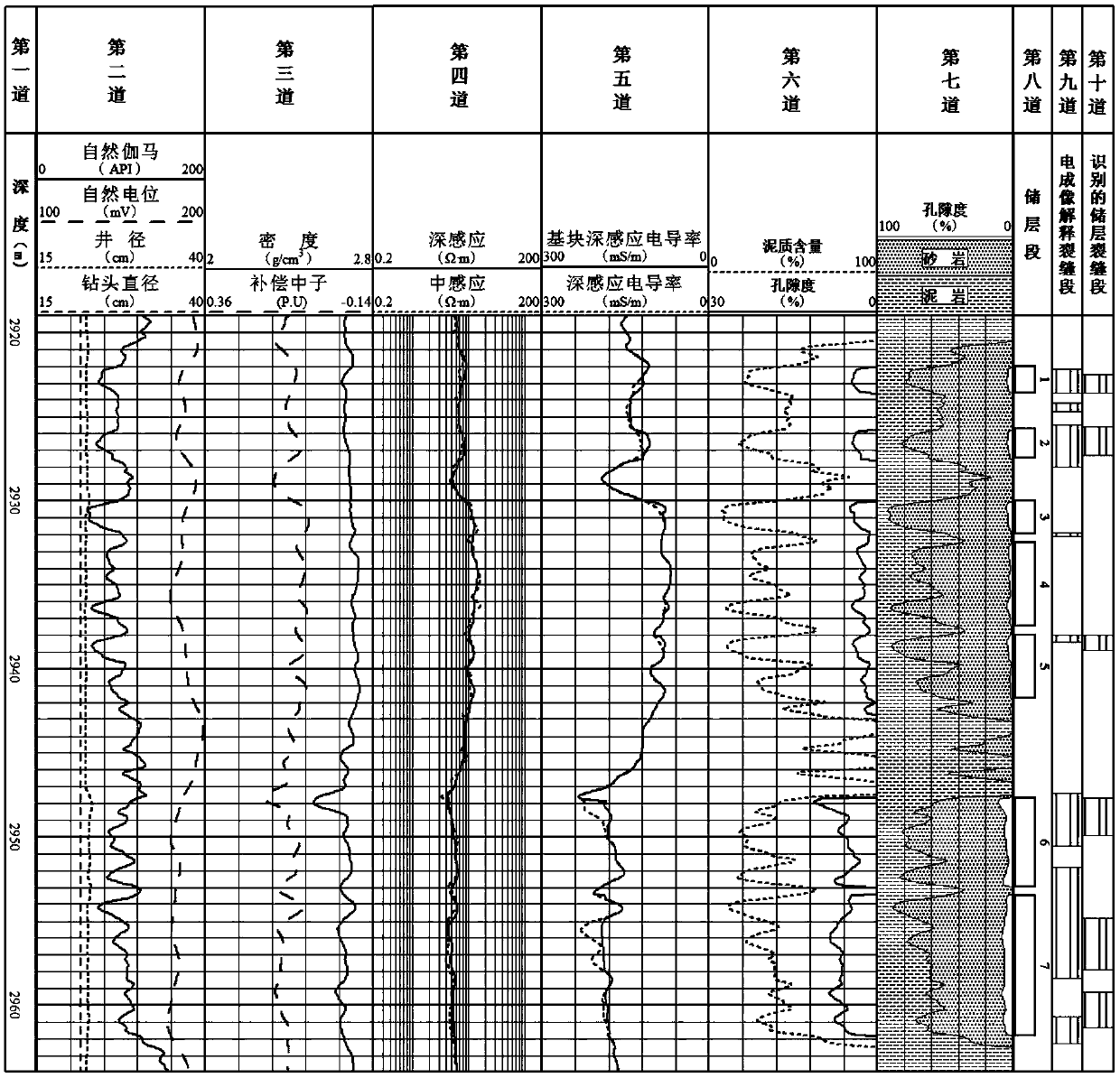[0002] Tight sandstone reservoirs are generally characterized by low porosity and
low permeability, and fractures often play an important role in tight sandstone oil and gas reservoirs. Fractures can significantly improve the seepage capacity of reservoirs and promote the development of this type of oil and gas reservoirs with industrial value. scale, the current methods for identifying reservoir fractures mainly include drilling and
coring, imaging
logging, conventional logging, etc. Drilling and coring can directly observe the development of fractures, but due to factors such as cost, ordinary wells do not
Coring, and stress release will also lead to the appearance of non-formation fractures in the core; imaging logging is an important technical means to identify reservoir fractures in modern logging technology, but it is also limited by the cost of logging, there are only a few in a research area Only key wells will be measured; most of the wells in the study area have conventional logging data, but using conventional logging data to identify fractures in tight sandstone oil and gas
layers has always been a difficult problem in logging evaluation technology
[0003] The existing method of conventional logging data to identify reservoir fractures in oil and gas reservoirs is realized by calibrating conventional logging data with limited drilling coring data and imaging logging data. There are mainly four methods for using conventional logging data to identify tight sandstone oil and gas. The method of hiding reservoir fractures: the first method is the double lateral resistivity difference method. When there are no fractures and no radial resistivity changes in the formation, the deep and shallow lateral resistivities should be coincident, and horizontal fractures can strengthen the lateral resistivity. The focusing effect of well logging reduces the measured resistance, and the focusing effect of horizontal fractures on the deep lateral resistivity is stronger than that of the shallow lateral resistivity, so that the deep lateral resistivity value is smaller than the shallow lateral resistivity, that is, Negative difference, the effective conductive section of the high-angle fracture remains unchanged in the radial direction, while the conductive section of the pore gradually increases in the radial direction, so within the shallow laterolog detection range, the ratio of the effective conductive section of the fracture to the pore It is much larger than the deep lateral log, so that the deep lateral resistivity value is greater than the shallow lateral resistivity value, which is a positive difference. It is often impossible to qualitatively identify effective fractures by using the dual lateral resistivity difference method. In addition, limited by the formation conditions in the study area, the
resistivity logging of conventional logging is only deep and medium
induction logging, and there is no dual Lateral logging, due to the difference in the focusing principle of the two
resistivity logging series, this method also loses its effect; the second method is the deep lateral resistivity or deep induction resistivity feature method, which is caused by the invasion of
drilling fluid The deep lateral resistivity or deep induced resistivity at fractures dropped obviously, but due to geological factors such as the existence of muddy bands in oil and gas
layers and the reduction of oil saturation, the deep lateral resistivity or deep induced resistivity may In the application process, the deep lateral resistivity or deep induction resistivity characteristic method cannot use a fixed standard to measure whether there are effective fractures in the reservoir, and it is easy to misjudgment; the third method is the acoustic
time difference characteristic method. When the fractures occur in low-angle or oblique fractures, the acoustic
time difference will increase locally or even jump, but when the fractures occur in high-angle or vertical fractures, the acoustic
time difference is basically not affected by the fractures. , in addition, under conditions such as
wellbore collapse, reservoir undercompaction, and gas reservoirs, etc., it often indicates the characteristics of local increase in acoustic time difference, so the qualitative identification of fractures by the method of acoustic time difference characteristics often leads to misjudgment; The fourth method is the fracture comprehensive identification parameter method, through a series of fracture identification parameters constructed by the predecessors using conventional logging curves in some specific research areas: three porosity
ratio method, equivalent
elastic modulus difference
ratio method, borehole
diameter Relative difference method, resistivity intrusion correction difference
ratio method, etc. use simple mathematical operations to establish a comprehensive identification parameter to identify cracks, but these parameters are difficult to use an accurate limit to measure whether cracks are developed. Using these comprehensive identification parameters to identify cracks cracked approach also often leads to misjudgments
In a word, in the process of identifying fractures in tight sandstone reservoirs using the above-mentioned prior art methods, there are defects such as poor certainty, artificial qualitative, and easy misjudgment. Rational and effective development of oil and gas reservoirs brings obstacles
 Login to View More
Login to View More  Login to View More
Login to View More 


